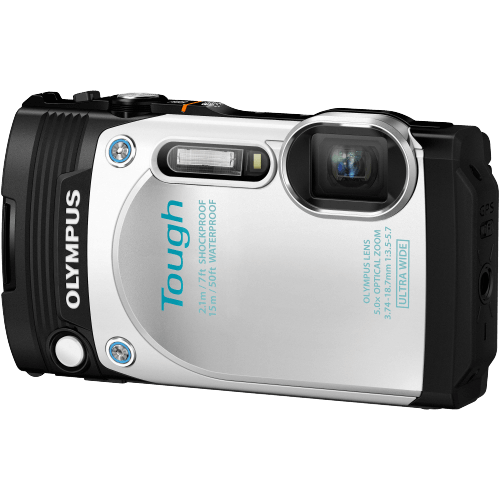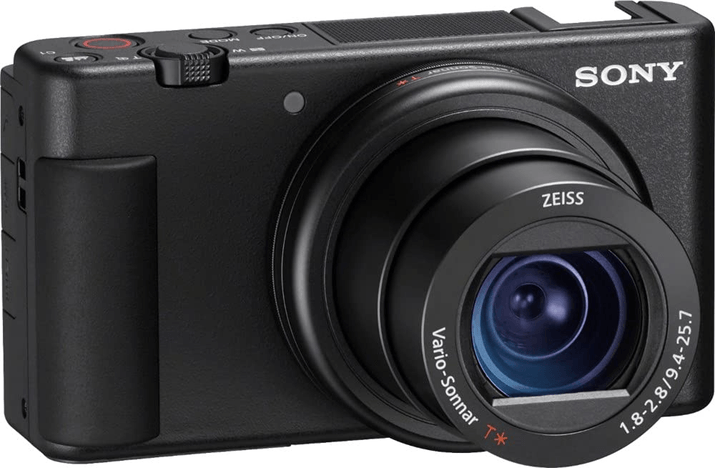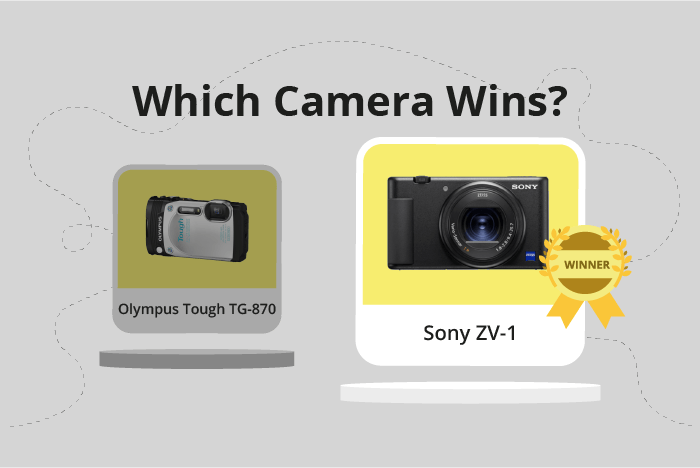Olympus Tough TG-870 vs Sony ZV-1 Comparison
Olympus Tough TG-870

Sony ZV-1

The Sony ZV-1 outperforms the Olympus Tough TG-870 with a score of 65/100 compared to 51/100. Both cameras are compact in design and share similarities in specifications. They were announced in 2020 and 2016, respectively, with the Sony ZV-1 having a higher launch price of $800, whereas the Olympus Tough TG-870 was priced at $279.
The Sony ZV-1 has the edge due to its better overall performance. However, the Olympus Tough TG-870 is lighter, weighing only 221g compared to the Sony’s 294g, making it easier to carry around. The size of the Olympus is also slightly larger, measuring 113 x 64 x 28mm, while the Sony ZV-1 measures 105 x 60 x 44mm.
Despite the higher score and better performance, the Sony ZV-1 comes at a higher price, which may be a deciding factor for some consumers. On the other hand, the Olympus Tough TG-870 offers a more budget-friendly option with a lighter and slightly larger design. Ultimately, the choice between these two cameras depends on the individual’s preferences and budget.
Olympus Tough TG-870 vs Sony ZV-1 Overview and Optics
The Sony ZV-1 emerges as the winner in our optics comparison, scoring 67/100, while the Olympus Tough TG-870 trails behind with a score of 53/100. Both cameras share certain specifications, such as having a CMOS sensor, fixed lens mount, and image stabilization. However, there are notable differences that contribute to the Sony ZV-1’s superior performance.
The Sony ZV-1 has a higher resolution, boasting 20 megapixels compared to the Olympus Tough TG-870’s 16 megapixels. This allows for better image quality and detail. Additionally, the Sony ZV-1 has a faster shooting speed of 24 frames per second, whereas the Olympus Tough TG-870 has a shooting speed of 7 frames per second. The faster shooting speed translates to improved performance in capturing fast-moving subjects.
Furthermore, the Sony ZV-1 features a larger sensor size of 1″ compared to the Olympus Tough TG-870’s 1/2.3″ sensor. The larger sensor contributes to better low-light performance and increased dynamic range. The Sony ZV-1 also has a higher DXOMARK score of 82, reflecting its superior image quality.
On the other hand, the Olympus Tough TG-870 has a different aspect ratio of 4:3, compared to the Sony ZV-1’s 3:2 aspect ratio. This difference in aspect ratio is a matter of personal preference and does not necessarily indicate better performance.
Taking these factors into account, the Sony ZV-1 outperforms the Olympus Tough TG-870 in terms of optics. Its higher resolution, faster shooting speed, larger sensor, and better image quality make it the clear choice for those prioritizing camera performance.
Olympus Tough TG-870 vs Sony ZV-1 Video Performance
The Sony ZV-1 outperforms the Olympus Tough TG-870 in video capabilities, with a score of 91/100 compared to the TG-870’s 70/100. Both cameras share common features, such as having time-lapse functionality built-in, but the ZV-1 surpasses the TG-870 in several key aspects.
The Sony ZV-1 offers 4K video resolution, whereas the Olympus Tough TG-870 only provides Full HD. The ZV-1’s maximum video dimensions are 3840 x 2160, while the TG-870’s are limited to 1920 x 1080. This higher resolution allows the ZV-1 to capture more detail and produce better quality videos.
Additionally, the Sony ZV-1 has a maximum video frame rate of 120fps, double the TG-870’s 60fps. A higher frame rate enables smoother motion and is especially useful for slow-motion video capture. The ZV-1’s superior video resolution and frame rate make it a more suitable choice for those looking to create high-quality videos.
On the other hand, the Olympus Tough TG-870 still offers decent video capabilities, with Full HD resolution and a 60fps frame rate. While not as impressive as the ZV-1’s specifications, these features are sufficient for casual users or those with less demanding video requirements.
Taking these factors into consideration, the Sony ZV-1 is the clear winner in video capabilities. Its 4K resolution and 120fps frame rate provide superior video quality compared to the Olympus Tough TG-870. However, the TG-870’s Full HD resolution and 60fps frame rate may still be adequate for users with less demanding video needs.
Olympus Tough TG-870 vs Sony ZV-1 Features and Benefits
The Sony ZV-1 outperforms the Olympus Tough TG-870 with a feature score of 68/100, compared to the Olympus’s 54/100. Both cameras share several specifications, including a 3-inch screen size, flip screen functionality, and built-in WIFI. However, the Sony ZV-1 has a slightly higher screen resolution at 921,600 dots, while the Olympus TG-870 has a resolution of 921,000 dots.
The Sony ZV-1 is the better camera due to its additional features. It includes a touchscreen, making it more user-friendly and easier to navigate than the Olympus TG-870, which lacks this feature. Moreover, the Sony ZV-1 has Bluetooth connectivity, allowing for seamless pairing with compatible devices and remote control options.
On the other hand, the Olympus Tough TG-870 has a built-in GPS, which is absent in the Sony ZV-1. This feature is useful for geotagging photos and tracking locations during outdoor adventures or travels. However, this advantage is not enough to make up for the overall superior features of the Sony ZV-1.
In comparing the two cameras, the Sony ZV-1 offers a higher feature score and additional advantages, such as a touchscreen and Bluetooth connectivity. These enhancements make it more versatile and user-friendly than the Olympus Tough TG-870. While the Olympus camera has the benefit of built-in GPS, the Sony ZV-1 is the clear winner in terms of overall features and functionality.
Olympus Tough TG-870 vs Sony ZV-1 Storage and Battery
The Sony ZV-1 outperforms the Olympus Tough TG-870 in storage and battery with a score of 29 to 16. Both cameras have a single memory card slot and accept SD, SDHC, and SDXC cards. However, the ZV-1 also supports Memory Stick Pro Duo and Pro-HG Duo cards, giving it an advantage in storage options.
In terms of battery life, the TG-870 holds a slight edge with 300 shots per charge, compared to the ZV-1’s 260 shots. The TG-870 uses a Li-50B battery, while the ZV-1 relies on an NP-BX1 battery. Despite having a shorter battery life, the ZV-1 compensates with USB charging capabilities, which the TG-870 lacks.
To conclude, the Sony ZV-1 has better storage options and the convenience of USB charging, while the Olympus Tough TG-870 offers slightly longer battery life. The ZV-1’s overall higher score in storage and battery reflects its advantages in these aspects.
Olympus Tough TG-870 vs Sony ZV-1 – Our Verdict
Are you still undecided about which camera is right for you? Have a look at these popular comparisons that feature the Olympus Tough TG-870 or the Sony ZV-1:

